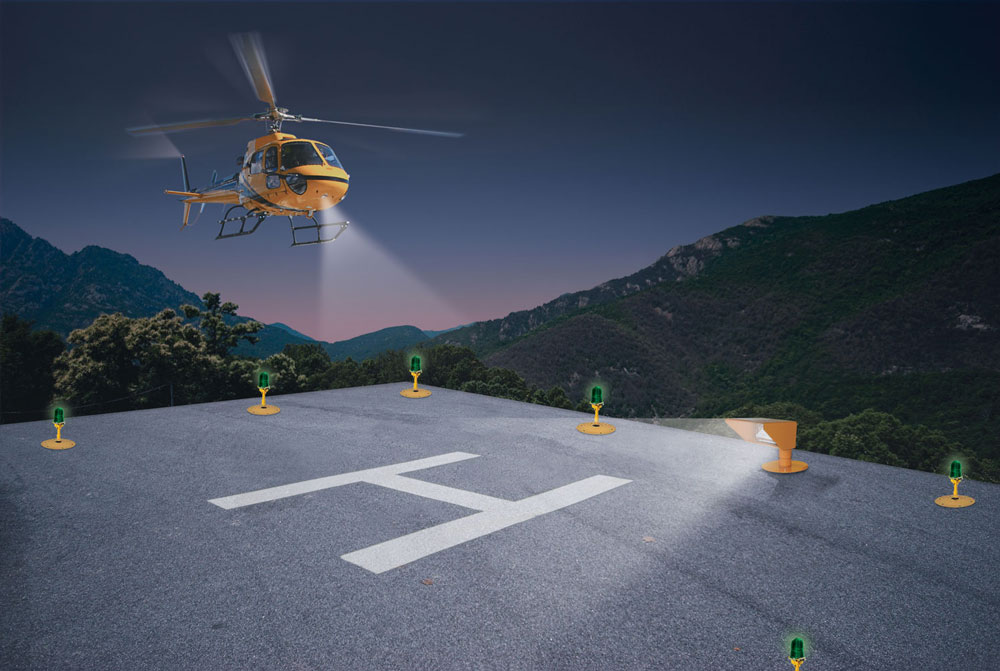Heliport and Vertiport Facilities
Jul 24th 2023
Heliports and vertiports play a crucial role in facilitating helicopter and tiltrotor landing operations. These specialized facilities are designed to provide safe and efficient landing areas for vertical takeoff and landing aircraft.
While traditional airports primarily cater to fixed-wing aircraft, heliports and vertiports are specifically tailored to meet the unique needs of helicopters and tiltrotors. Unlike airports, which often have long runways, heliports/vertiports feature designated landing pads or helipads that allow for vertical landings and takeoffs.
It is interesting to note that approximately 90% of current heliport/vertiport facilities are of the simple single-aircraft variety. These smaller-scale facilities are typically found in urban areas, hospitals, corporate campuses, or other locations where quick access is essential.
Heliports/vertiports serve a wide range of purposes, including emergency medical services, search and rescue operations, executive transportation, offshore oil rig support, tourism activities, law enforcement missions, and more. They play a vital role in connecting people and resources efficiently across various industries.
As technology continues to advance in the aviation sector with the emergence of electric vertical takeoff and landing (eVTOL) aircraft concepts, the demand for well-equipped heliports/vertiports is expected to grow. These futuristic aircraft will require specialized infrastructure that can support their unique operational requirements.
Heliports/vertiports serve as dedicated hubs for helicopter and tiltrotor operations. With their ability to accommodate vertical landings/takeoffs efficiently, they contribute significantly to various industries' transportation needs while ensuring safety and convenience for both pilots and passengers alike.
When it comes to aviation infrastructure, it's important to understand the key differences between a helistop/heliport and a vertiport/vertistop. While both serve as landing areas for vertical takeoff and landing (VTOL) aircraft, they have distinct characteristics and functionalities.
A helistop is typically an open area designated for helicopter landings and takeoffs. It can be a simple landing pad or a small area on the ground that meets the necessary safety requirements. Heliports, on the other hand, are more developed facilities with additional features such as lighting, markings, wind indicators, and communication systems. They are often used for commercial purposes or emergency services.
On the other hand, a vertiport is specifically designed to cater to electric vertical takeoff and landing (eVTOL) aircraft. It goes beyond just providing a landing area by offering comprehensive support facilities such as fueling stations, hangaring options, maintenance services, and trained attendants. Vertiports are essential in enabling urban air mobility (UAM) and facilitating the transportation of passengers in densely populated areas.
Lastly, a vertistop is similar to a helistop in that it serves as an area for VTOL aircraft landings and takeoffs. However, like its counterpart - the vertiport - it also has multi-use capabilities. This means that it can accommodate various types of VTOL aircraft while providing flexibility for different applications such as passenger transport or cargo delivery.
In summary, while both helistops/heliports and vertiports/vertistops serve as landing areas for VTOL aircraft, their distinctions lie in their level of development and supporting facilities. Heliports primarily cater to helicopters with basic amenities while vertiports offer comprehensive support services for eVTOL operations. Vertistops combine the concept of multi-use capabilities with VTOL functionality.
When it comes to heliport/vertiport facilities, the sizes can vary depending on the type and size of the helicopters they are designed to accommodate. From small two-seat helicopters to medium twin-engine helicopters, there are specific size requirements to ensure safe and efficient operations.
For a small two-seat helicopter, a typical heliport/vertiport facility would have an open area of around 64' x 64'. This provides enough space for takeoff, landing, and maneuvering.
On the other hand, for a medium twin-engine helicopter, the facility would need to be larger. The recommended size for such helicopters is around 109' x 109'. This allows for adequate space for approach and departure routes while maintaining safety standards.
It's important to note that these sizes are just general guidelines and can vary based on specific regulations and requirements set by local authorities. Additionally, there are approach slope requirements in place to ensure safe operations during takeoff and landing.
Heliport/vertiport facilities come in different sizes depending on the type of helicopter they cater to. From smaller areas suitable for two-seat helicopters to larger spaces accommodating medium twin-engine helicopters, these facilities adhere to specific size guidelines while also considering approach slope requirements for safe operations.
Heliports and vertiports play a crucial role in providing efficient and safe air transportation facilities for various purposes. Let's explore the different types of heliports/vertiports that cater to different needs and requirements.
Private heliports are primarily designed for individuals or organizations who own helicopters for personal or business use. These heliports are typically located on private properties such as estates, corporate headquarters, or luxury resorts, allowing convenient access to air travel.
General aviation heliports serve as public facilities that accommodate a wide range of aircraft, including helicopters. These heliports provide services to private pilots, recreational flyers, flight schools, and small charter operators. They often have fueling stations, maintenance facilities, and other amenities to support general aviation activities.
Transport facilities include heliports/vertiports located near transportation hubs such as airports or train stations. These facilitate seamless connections between different modes of transportation and offer convenient options for travelers looking to reach their destinations quickly.
Hospital facilities feature dedicated helipads or landing sites at medical centers. These are essential for medical emergencies where helicopters can quickly transport patients from accident scenes or remote locations to hospitals equipped with specialized care.
Official-use facilities are designated for government agencies or official purposes. They may be utilized by law enforcement agencies, military operations, government officials' transportations, or any other official activities requiring helicopter access.
Medical emergency sites serve as temporary landing zones in remote areas where immediate medical attention is required due to accidents or natural disasters. These sites enable quick evacuation and transportation of patients to nearby medical centers.
Emergency evacuation facilities are strategically positioned at disaster-prone areas to aid in swift evacuations during emergencies like floods, earthquakes, or wildfires. Helicopters can rapidly evacuate people from these locations when conventional means of transportation are not feasible.
Temporary facilities refer to temporary landing zones set up for specific events like concerts, sports events, festivals, or construction projects that require aerial support. These temporary heliports/vertiports provide a convenient and secure means of transportation for participants, VIPs, or workers.
In conclusion, the various types of heliports/vertiports cater to different needs and purposes, ranging from private use to public transportation, medical emergencies to official activities. Each type serves a specific function in ensuring efficient air connectivity and safety across various sectors.
Heliport/vertiport facilities have the potential to revolutionize transportation and provide a convenient mode of travel in urban areas. The flexibility of these facilities allows them to be located in various settings, depending on the available space and infrastructure.
One option is to have heliports/vertiports located on ground-level areas with sufficient space. These can be designated areas specifically designed for helicopter takeoffs and landings. Ground-level heliports offer easy accessibility and can be integrated into existing transportation hubs or open spaces.
Another possibility is to have heliports/vertiports elevated on buildings, parking garages, canopies, bridges, or over freeways and interstates. This vertical placement maximizes space utilization in densely populated urban environments where ground-level space may be limited.
Additionally, heliport/vertiport facilities can be situated on docks, piers, barges, boats, offshore oil/gas rigs, or portable deck systems. These locations cater to specific needs such as maritime operations or remote areas where traditional infrastructure is not readily available.
The key factor in determining the location of these facilities is ensuring safety and compliance with regulations. Factors such as airspace restrictions and proximity to residential areas need to be considered when selecting suitable locations for heliport/vertiport facilities.
Heliport/vertiport facilities can be located anywhere there is sufficient space and meet the necessary safety requirements. Whether it's on ground-level spaces, elevated structures, or even maritime settings – the potential for expanding this mode of transportation is vast.
Genesis Lamp is your Source for Heliport Lighting

